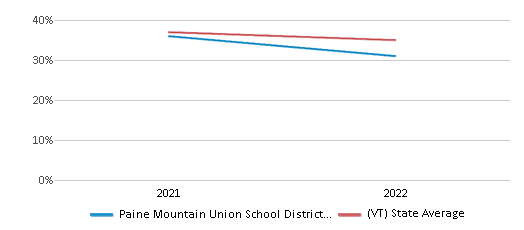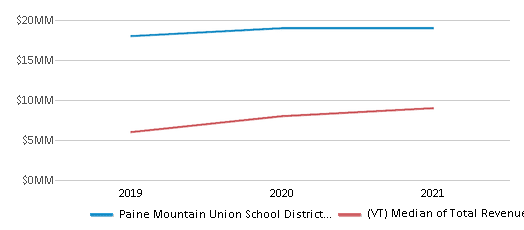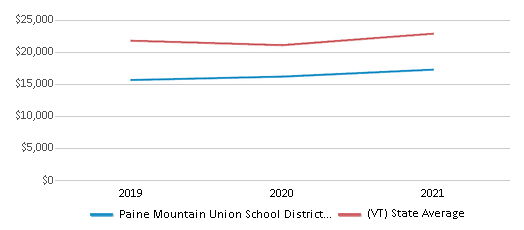For the 2025 school year, there are 4 public schools serving 1,024 students in Paine Mountain Union School District #68. This district's average testing ranking is 5/10, which is in the bottom 50% of public schools in Vermont.
Public Schools in Paine Mountain Union School District #68 have an average math proficiency score of 25% (versus the Vermont public school average of 33%), and reading proficiency score of 38% (versus the 44% statewide average).
Minority enrollment is 9% of the student body (majority Hispanic), which is less than the Vermont public school average of 13% (majority Hispanic and Black).
Overview
This School District
This State (VT)
# Schools
4 Schools
306 Schools
# Students
1,024 Students
78,642 Students
# Teachers
80 Teachers
7,167 Teachers
Student : Teacher Ratio
13:1
13:1
District Rank
Paine Mountain Union School District #68, which is ranked within the bottom 50% of all 102 school districts in Vermont (based off of combined math and reading proficiency testing data) for the 2021-2022 school year.
The school district's graduation rate of 75% has stayed relatively flat over five school years.
Overall District Rank
#98 out of 154 school districts
(Bottom 50%)
(Bottom 50%)
Math Test Scores (% Proficient)
25%
33%
Reading/Language Arts Test Scores (% Proficient)
38%
44%
Science Test Scores (% Proficient)
31%
35%

Graduation Rate
75%
83%
Students by Ethnicity:
Diversity Score
0.17
0.23
# American Indian Students
2 Students
202 Students
% American Indian Students
n/a
n/a
# Asian Students
8 Students
1,604 Students
% Asian Students
1%
2%
# Hispanic Students
41 Students
2,652 Students
% Hispanic Students
4%
3%
# Black Students
10 Students
2,114 Students
% Black Students
1%
3%
# White Students
931 Students
68,754 Students
% White Students
91%
88%
# Hawaiian Students
n/a
56 Students
% Hawaiian Students
n/a
n/a
# Two or more races Students
32 Students
3,304 Students
% of Two or more races Students
3%
4%
Students by Grade:
# Students in PK Grade:
98
8,002
# Students in K Grade:
63
5,145
# Students in 1st Grade:
69
5,342
# Students in 2nd Grade:
72
5,706
# Students in 3rd Grade:
66
5,327
# Students in 4th Grade:
71
5,812
# Students in 5th Grade:
76
5,556
# Students in 6th Grade:
77
5,670
# Students in 7th Grade:
74
5,534
# Students in 8th Grade:
61
5,596
# Students in 9th Grade:
87
5,400
# Students in 10th Grade:
78
5,537
# Students in 11th Grade:
72
5,331
# Students in 12th Grade:
60
4,684
# Ungraded Students:
-
-
District Revenue and Spending
The revenue/student of $18,163 in this school district is less than the state median of $29,860. The school district revenue/student has stayed relatively flat over four school years.
The school district's spending/student of $17,258 is less than the state median of $29,121. The school district spending/student has stayed relatively flat over four school years.
Total Revenue
$19 MM
$2,348 MM

Spending
$18 MM
$2,290 MM

Revenue / Student
$18,163
$29,860

Spending / Student
$17,258
$29,121

Best Paine Mountain Union School District #68 Public Schools (2025)
School
(Math and Reading Proficiency)
(Math and Reading Proficiency)
Location
Grades
Students
Rank: #11.
Northfield Elementary School
(Math: 30-34% | Reading: 40-44%)
Rank:
Rank:
5/
Bottom 50%10
10 Cross Street
Northfield, VT 05663
(802) 485-6161
Northfield, VT 05663
(802) 485-6161
Grades: PK-5
| 283 students
Rank: #22.
Northfield Middle/high School
(Math: 20-24% | Reading: 45-49%)
Rank:
Rank:
4/
Bottom 50%10
37 Cross Street Unit 2
Northfield, VT 05663
(802) 485-4500
Northfield, VT 05663
(802) 485-4500
Grades: 6-12
| 243 students
Rank: #33.
Williamstown Elementary School
(Math: 30-34% | Reading: 30-34%)
Rank:
Rank:
4/
Bottom 50%10
100 Brush Hill Road
Williamstown, VT 05679
(802) 433-6653
Williamstown, VT 05679
(802) 433-6653
Grades: PK-5
| 232 students
Rank: #44.
Williamstown Middle/high School
(Math: 15-19% | Reading: 30-34%)
Rank:
Rank:
2/
Bottom 50%10
120 Hebert Road
Williamstown, VT 05679
(802) 433-5350
Williamstown, VT 05679
(802) 433-5350
Grades: 6-12
| 266 students
Frequently Asked Questions
How many schools belong to Paine Mountain Union School District #68?
Paine Mountain Union School District #68 manages 4 public schools serving 1,024 students.
What is the rank of Paine Mountain Union School District #68?
Paine Mountain Union School District #68 is ranked #61 out of 102 school districts in Vermont (bottom 50%) based off of combined math and reading proficiency testing data for the 2021-2022 school year.
What is the racial composition of students in Paine Mountain Union School District #68?
91% of Paine Mountain Union School District #68 students are White, 4% of students are Hispanic, 3% of students are Two or more races, 1% of students are Asian, and 1% of students are Black.
What is the student/teacher ratio of Paine Mountain Union School District #68?
Paine Mountain Union School District #68 has a student/teacher ratio of 13:1, which is higher than the Vermont state average of 11:1.
What is Paine Mountain Union School District #68's spending/student ratio?
The school district's spending/student of $17,258 is less than the state median of $29,121. The school district spending/student has stayed relatively flat over four school years.
Recent Articles

Year-Round Or Traditional Schedule?
Which is more appropriate for your child? A year-round attendance schedule or traditional schedule? We look at the pros and cons.

Why You Should Encourage Your Child to Join a Sports Team
Participating in team sports has a great many benefits for children, there is no doubt. In this article you will learn what those benefits are.

White Students are Now the Minority in U.S. Public Schools
Increasing birth rates among immigrant families from Asia and Central and South America, combined with lower birth rates among white families, means that for the first time in history, public school students in the United States are majority-minority. This shift in demographics poses difficulties for schools as they work to accommodate children of varying language abilities and socio-economic backgrounds.





